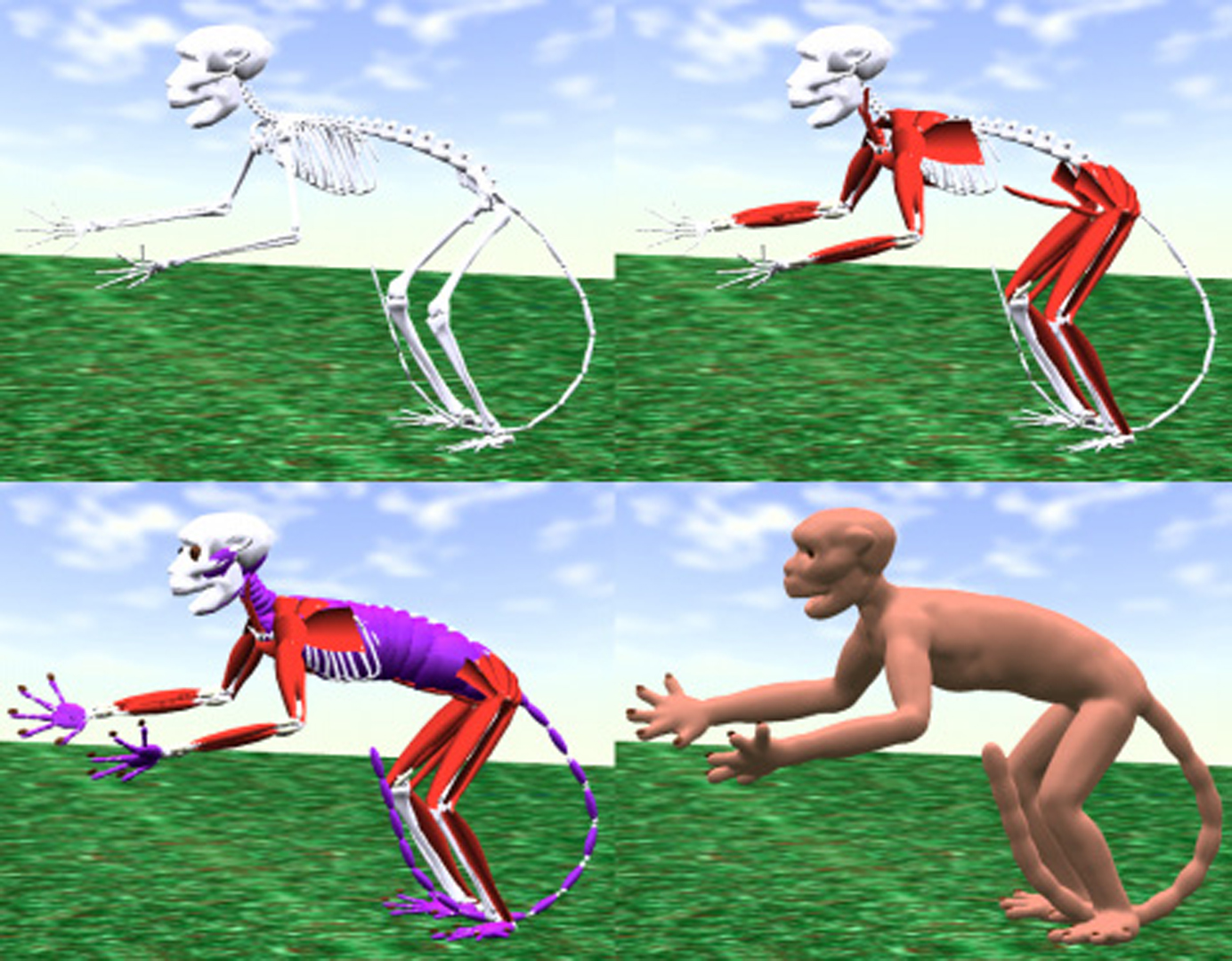“Anatomically based modeling” by Wilhelms and Van Gelder
Conference:
Type(s):
Title:
- Anatomically based modeling
Presenter(s)/Author(s):
Abstract:
We describe an improved, anatomically based approach to modeling and animating animals. Underlying muscles, bones, and generalized tissue are modeled as triangle meshes or ellipsoids. Muscles are deformable discretized cylinders lying between fixed origins and insertions on specific bones. Default rest muscle shapes can be used, or the rest muscle shape can be designed by the user with a small set of parameters. Muscles automatically change shape as the joints move. Skin is generated by voxelizing the underlying components, filtering, and extracting a polygonal isosurface. Isosurface skin vertices are associated with underlying components and move with them during joint motion. Skin motion is consistent with an elastic membrane model. All components are parameterized and can be reused on similar bodies with non-uniformly scaled parts. This parameterization allows a non-uniformly sampled skin to be extracted, maintaining more details at the head and extremities.
References:
1. James F. Blinn. A Generalization of Algebraic Surface Drawing. ACM Transactions on Graphics, 1(3):235-256, July 1982.]]
2. John E. Chadwick, David R. Haumann, and Richard E. Parent. Layered Construction for Deformable Animated Characters. In Computer Graphics (SIGGRAPH 89 Conference Proceedings), volume 23 of Annual Conference Series, pages 242- 252. Addison Wesley, August 1989.]]
3. David T. Chen and David Zeltzer. Pump It Up: Computer Animation Based Model of Muscle Using the Finite Element Method. In Computer Graphics (SIGGRAPH 92 Conference Proceedings), volume 26, pages 89-98. Addison Wesley, July 1992.]]
4. Scott L. Delp and J. Peter Loan. A Graphics-based Software System to Develop and Analyze Models of Musculoskeletal Structures. Computers in Biology and Medicine, 25(1):21- 34, 1995.]]
5. Jean-Paul Gourret, Nadia Magnenat-Thalmann, and Daniel Thalmann. Simulation of Object and Human Skin Deformations in a Grasping Task. In Computer Graphics (SIGGRAPH 89 Conference Proceedings), volume 23, pages 21-30. Addison Wesley, July 1989.]]
6. Mark Henne. A Constraint-Based Skin Model for Human Figure Animation. Master’s thesis, University of California, Santa Cruz, Santa Cruz, CA 95064, June 1990.]]
7. R. M. Koch, M. H. Gross, F. R. Carls, D. F. von Buerin, G. Fankhauser, and Y. I. H. Parish. Simulating Facial Surgery Using Finite Element Models. In SIGGRAPH 96 Conference Proceedings, Annual Conference Series, pages 421-428. ACM SIGGRAPH, Addison Wesley, August 1996.]]
8. K. Komatsu. Human Skin Model Capable of Natural Shape Variation. The Visual Computer, 4(3):265-271, 1988.]]
9. Yuencheng Lee, Demetri Terzopoulos, and Keith Waters. Realistic modeling for facial animation. In SIGGRAPH 95 Conference Proceedings, Annual Conference Series, pages 55-62. ACM SIGGRAPH, Addison Wesley, 1995.]]
10. Nadia Magnenat-Thalmann and Daniel Thalmann. Human Body Deformations Using Joint-Dependent Local Operators and Finite Element Theory. In N. Badler, B. Barsky, and D. Zeltzer, editors, Making Them Move. Morgan Kaufmann Publishers, Inc., San Mateo, CA, 1991.]]
11. Ferdi Scheepers, Richard E. Parent, Wayne E. Carlson, and Stephen F. May. Anatomy-based modeling of the human musculature. In SIGGRAPH 97 Conference Proceedings, Annual Conference Series. ACM SIGGRAPH, Addison Wesley, August 1997.]]
12. Thomas W. Sederberg and Scott R. Parry. Free-form deformations of solid geometric objects. In Computer Graphics (SIGGRAPH 92 Conference Proceedings), volume 20, pages 151-160. Addison Wesley, August 1986.]]
13. Karansher Singh, Jun Ohya, and Richard Parent. Human figure synthesis and animation for virtual space teleconferencing. In Proceedings of the Virtual Reality Annual International Symposium ’95, pages 118-126, Research Triangle Park, N.C., March 1995. IEEE Computer Society Press.]]
14. R. Turner and D. Thalmann. The Elastic Surface Layer Model for Animated Character Construction. In N. M. Thalmann and D. Thalmann, editors, Proceedings of Computer Graphics International ’93, pages 399-412, Lausanne, Switzerland, June 1993. Springer-Verlag.]]
15. Allen Van Gelder and Jane Wilhelms. Interactive Animated Visualization of Flow Fields. In 1992 Workshop on Volume Visualization, pages 47-54, Boston, Mass., October 1992. ACM.]]
16. Allen Van Gelder and Jane Wilhelms. An Interactive Fur Modeling Technique. In Proceedings of Graphics Intelface, May 1997.]]
17. Allen Van Gelder and Jane Wilhelms. Simulation of Elastic Membranes and Soft Tissue with Triangulated Spring Meshes. Technical Report UCSC-CRL-97-12, CS Dept., University of California, 225 A.S., Santa Cruz, CA 95064, January 1997.]]
18. Marvalee H. Wake, editor. Hyman’s Comparative Vertebrate Anatomy. University of Chicago Press, Chicago, Illinois, third edition edition, 1979.]]
19. Jane Wilhelms. Animals with Anatomy. IEEE Computer Graphics and Applications, 17(3):22-30, May 1997.]]
20. Jane Wilhelms and Allen Van Gelder. Anatomically Based Modeling. Technical Report UCSC-CRL-97-10, CS Dept., University of California, 225 A.S., Santa Cruz, CA 95064, April 1997.]]
21. Yin Wu, R Kalra, and N. M. Thalmann. Simulation of Static and Dynamic Wrinkles of Skin. In Proceedings of Computer Animation ’96, pages 90-97, Geneva, Switzerland, June 3-4 1996. IEEE Computer Society Press.]]





